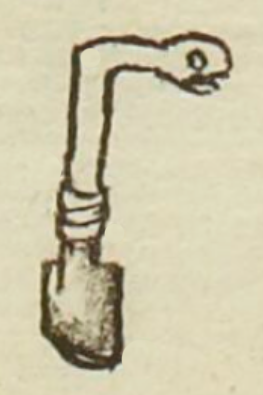Axoquen (MH535r)
This black-line drawing of the simplex glyph for the agricultural tool called the axoquen shows a frontal view of a shovel-like tool with a bent handle (probably wooden). At the end of the handle may be a bird head, given that "axoquen" is also a name for a bird (see our Online Nahuatl Dictionary). Alternatively, the animal head may be from a serpent (coatl), given that digging sticks came to be called coas in Mexican Spanish. This animal head is shown in profile, facing toward the viewer's right.
Stephanie Wood
The term axoquen also means great blue heron. So, if the reading is not intended to be the agricultural too, it may be that the person was named for the heron. In that case, this glyph could be a simplex phonogram. Alternatively, the animal head may be from a serpent (coatl), given that digging sticks came to be called coas in Mexican Spanish (but with a Taíno origin).
Stephanie Wood
franco. axoquē
Francisco Axoquen
Stephanie Wood
1560
Jeff Haskett-Wood
tools, herramientas agrícolas, cabeza de serpiente

axoquen, farming tool, https://nahuatl.wired-humanities.org/content/axoquen
Matrícula de Huexotzinco, folio 535r, https://www.loc.gov/resource/gdcwdl.wdl_15282/?sp=149&st=image
This manuscript is hosted by the Library of Congress and the World Digital Library; used here with the Creative Commons, “Attribution-NonCommercial-ShareAlike 3.0 License” (CC-BY-NC-SAq 3.0).




